Richard Murphy is a marine biologist who has traveled all over the world with Jacques Cousteau and his son, Jean-Michel, exploring, helping to organize filming expeditions, and doing research. He works for Jean-Michel Cousteau’s Ocean Futures Society as a writer, scientist, photographer, and educator.

Monday, 29 Oct 2001
SANTA CRUZ, Calif.
I began this week in a particularly good mood. I spent the weekend on Catalina Island, where Ocean Futures conducts its Ambassadors of the Environment program, and had a great night dive. While on the ocean floor getting used to a new video camera, I discovered an angel shark resting on the sand. It was sort of flat, like a ray, and it just sat there, camouflaged on the floor, waiting for a meal to swim by. I was approaching slowly, adjusting my lights to the subject, when all of a sudden a sable fish swam by. Right before my eyes, the angel shark arched up, lunged forward and engulfed the sable fish. And I got the sequence on camera. I don’t know whether the sable fish or I was more surprised … but I know I was definitely luckier.
So with a bit of ocean under my belt, I’m ready to get back to what we call reality and do some work. I spent today writing a description of a new Ambassadors of the Environment Program, this one to be held in Kona, Hawaii. The Catalina program has gone well, and with the launching of the Kona program, we’ll adapt the curriculum of a kelp bed ecosystem to a coral reef ecosystem.
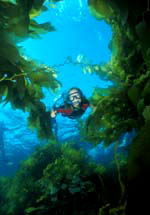
Ambassadors of the Environment student exploring the kelp bed on Catalina Island.
Photo: Ocean Futures Society.
Ambassadors of the Environment is Ocean Future’s attempt to help the next generation not only appreciate the value of the great outdoors but also learn important lessons from nature about living sustainably. The Hawaii version of the program will use experiential education with frequent excursions into the marine and terrestrial environments to address these issues.
Students in the Hawaii program will be introduced to the natural wonders of Kona’s marine and coastal environments through slide shows, diving excursions, and discussions. The discussions will focus on biodiversity, the unique characteristics of the region, human impact, and resource management. Students will participate in long-term monitoring and restoration programs, to be created in conjunction with local groups already involved in such projects.
In addition, participants will be shown important principles of biological and ecological sciences and how they relate to ecosystem sustainability. Students will be challenged to compare how a marine community functions to how their own human communities operate, exploring which is more sustainable and why. Sustainable characteristics of human communities will be demonstrated and experienced in the camp’s solar collectors, solar still, composting toilets, recycling programs, gardens, integrated systems, and efficiency programs.
Infused into the weeklong process will be opportunities for students to learn more about themselves and others through positive risk-taking. Students will be presented with personal and group challenges ranging from rock climbing and hiking to problem-solving sessions that stress interconnections. Students will also be given a real world simulation exercise in which they will have to reconcile a hypothetical development in terms of economic and environmental sustainability.
An important theme running through the entire program will be “Everything is Connected.” Activities and discussions will focus on the fact that the land and sea are connected, that humans are connected to nature, that people are connected to other people and that the present is connected to the future.
By providing an adventurous learning environment, we aim to create maximum opportunities for social, emotional, and academic growth. Students will be encouraged to share their new skills and knowledge when they return home. All participants will receive guidance and resources to help empower them as Ambassadors of the Environment and participate in the search for sustainability.
So how does it sound? To me, it sounds like fun — and also like a decent first draft for the program description. That means I can check my email, return some phone messages, and call it a day. I think I’ll go mountain biking in the redwoods where I live before the sun sets; hope you have a nice evening, too.
Tuesday, 30 Oct 2001
SANTA CRUZ, Calif.
My bike ride last night was awesome — I saw a mother wild pig with three piglets and, even more exciting, a bobcat that bounded across the road in front of me. I love seeing wild animals in nature; these kinds of encounters make me feel more connected to my environment.
Now, though, it’s back to work. Yesterday I was so excited about my weekend dive experience that I forgot to tell you anything about myself and my job. I live in a small cabin in the mountains just north of Santa Cruz, Calif., five miles inland from the ocean. I have a full-time job with Jean-Michel Cousteau’s Ocean Futures Society, but to save on fuel, highway clogging, and the time wasted driving to and from the office, I work out of my home. Since I have been working with Jean-Michel for 33 years, it’s pretty easy for us to communicate, even when we’re not physically in the same place.
Jean-Michel and I have had some amazing adventures together during the last three decades: diving with whales, climbing the mountain at the headwaters of the Amazon River, and filming coral reefs in places like Papua New Guinea and Fiji. (If you don’t already know where those places are, you may want to check them out on a map. One of the great things about my job has been all the unexpected lessons in geography and culture; I’ve learned a lot from traveling and being around people who see the world very differently than I do.)
Part of my job with Ocean Futures is to dream up new programs to help us educate people about the wonder of nature, its value to humans, how our behavior affects the world, and how we can live more sustainably on our little oasis in space — Planet Earth. (I think it should be called Planet Ocean, since most of the surface of our planet is covered with water.)
Today I received an email from Jean-Michel, asking me to think about a presentation he has been asked to make on how coral reefs are being affected by global warming and carbon dioxide emissions. This should not be too difficult because last year I attended the 9th International Coral Reef Symposium, where scientists from around the world came to share their research findings.
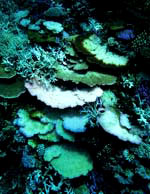
These white corals are suffering from water that is too warm.
Photo: Ocean Futures Society.
What I learned at the symposium was pretty grim. As of last year, 27 percent of the world’s coral reefs had been effectively lost, primarily as a result of warmer ocean temperatures, which cause corals to bleach and die. Bleaching means that corals turn white because they have lost the microscopic algae that live inside them and give them their color. The worst year in history for coral bleaching was 1998, when weather patterns known as El Nino and La Nina wreaked havoc on ocean temperatures.
El Nino and La Nina are natural occurrences, but our use of petroleum and the resultant release of carbon dio
xide is causing unnatural weather patterns: our climate is getting warmer, which is threatening coral reefs. One scientist at last year’s symposium foresaw a truly bleak marine future: “I surmise that reefs as they are known today will disappear.”
If we want to avert that fate, we need to reduce our energy use and increase our energy efficiency, for example by buying cars that get good gas mileage. I believe we can make a difference, but to do so every one of us will have to do everything we can to save energy. If we are able to face the reality of what is happening around us, we will be better able to make changes that will improve the health of coral reefs and of our planet.
Wednesday, 31 Oct 2001
SANTA CRUZ, Calif.
Today I got up early and went surfing as the sun rose. The water was cold, 54 degrees Fahrenheit, but the waves were great — about two feet overhead, clean and glassy. So even though it’s still morning, I’ve already had a good day; I feel charged and ready for work.
In checking my email, I found an invitation from the International Ecotourism Society to teach a workshop on marine ecotourism for the World Ecotourism Summit taking place in Quebec in 2002. Next year has been designated by the United Nations as the year of Ecotourism, so the opportunity to teach a workshop feels like a big deal and quite an honor.
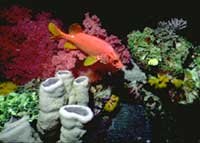
A soldier fish swims behind some gray sponges and in front of red soft corals.
Photo: Ocean Futures Society.
The author of the email asks for a range of ideas about what kind of workshop I’d like to present. Good question. My first thought is to conduct a workshop on the relevance of ecology to marine ecotourism development. To protect something it helps to know how it works, so it would be great to have a workshop on coral reef ecology, including a consideration of how we use energy and recycle waste, how biodiversity benefits the community and how everything is interconnected — even human beings and tiny marine critters.
I also propose a workshop on how human activities threaten coral reefs and what we can do to protect them. This workshop would focus on topics such as global warming (the effects of which I discussed yesterday); how sediments and nutrients stress corals; how using dynamite and cyanide to catch fish harms the entire reef community; and how pollution can impair coral reproduction. We would also discuss solutions to these problems — that is, how you can help at the local level, even if you live far from coral reefs. For example, a group called the Marine Aquarium Council certifies animals for the aquarium trade. Since many aquarium fish are captured in a way that is destructive to reefs, this group points the consumer to fish that have been caught responsibly, without harming reefs. Like dolphin-safe tuna, this is an example of how consumer awareness can help protect the environment.
Because I work for an educational organization, I also propose a workshop looking at educational programs and tourist expectations. The definition of ecotourism is “Responsible travel to natural areas that conserves the environment and improves the welfare of local people.” This means that tourists must be educated so they will understand how to behave responsibly and not harm either nature or native cultures. It also means that we must work with local people and promote education and environmental awareness in their communities. It is important to remember that people are part of the environment and we need to consider how our activities affect other people, directly and indirectly. Tourists can take fish and shells, eliminating sources of income for local people. On the other hand, tourists can also contribute funds to help community education programs. And tour operators can work with local communities to insure marine resources are managed sustainably so tourists can continue to pay for reef diving and local people can continue to harvest fish.
In all of these workshop proposals, I emphasize one of my favorite themes: interconnectivity. When we think about ecotourism, or agriculture, or industry, or development, we must think very carefully about all of the consequences of our actions to avoid damaging the marine environment. Coral reefs can be affected by everything from cutting the rainforest (sediments and nutrients from rainforest logging often end up in the sea) to population growth (more people means more sewage, which also can leak into the ocean). The goal must be to integrate human activities with nature in ways that minimize harm to the sea.
So that’s about it for my thoughts on the eco-tourism conference. Maybe I’ll see some of you there! One last note for the day: I just got the final proofs from the publisher of a book I wrote on coral reefs. The book (which, if I say so myself, contains spectacular photographs), looks at a coral reef as if it were a city. The coral city runs entirely on solar energy, everything is recycled, there is public health, as well as advertising (including false advertising), cheats and thieves, and even social security. For a science-y book, it’s pretty fun, as I try not to take science too seriously. In fact, I try not to take anything too seriously.
Thursday, 1 Nov 2001
SANTA CRUZ, Calif.
I started my day today by reviewing 30 emails and other such office chores, but I’ll spare you the details. Luckily, I had a much more interesting task awaiting me: This morning, I transcribed my notes from a great adventure I had in Fiji earlier this year. What follows are parts of a description of a day I spent with a pal of mine as we went on a traditional Fijian pig hunt.
My first sensation of the morning was a desire to choke one particularly enthusiastic rooster that had apparently assumed full responsibility for summoning the sun to rise. It was totally dark and, in my opinion, the rooster’s biological clock was way off. Reluctantly, I accepted the fact that the day I had been anticipating for four years would begin a bit earlier than I had hoped.
Breakfast consisted of cassava, rice, bananas, tea, and bread. By the time we were finished a group of six men and their 15 dogs were sitting outside the door, and it was time to go. I had no idea what to expect, beyond the short explanation that we were going into the bush after wild boar. Not being a bushman, I decided to travel light, taking only a camera and Swiss army knife. I wore hard-soled dive booties, shorts, a T-shirt, and my favorite hat of 20-plus years. Most of the others carried a bush knife, some had a small backpack, two had a heavy iron spear, and no one wore shoes.
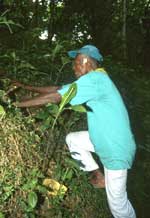
Niumaia leads an adventure in the Fijian rainforest.
Photo: Richard Murphy.
After a mile or so, we stopped under a large banyon tree. There was no underbrush, as the density of the leaves and secondary trunks prevented most light from penetrating to the ground. It was under this tree that Niumaia explained our strategy: We would proceed toward the top of the mountain, dividing into two groups so the dogs could roam between us, scouring the bush for pigs. He then walked some distance away and returned with an armful of leaves. These were salusalu leaves, used, as Niumaia put it, “to make the dogs hungry for the hunt.” He then called a dog, held it firmly, and buried its muzzle in a handful of leaves. The dog did not resist. Subsequently, the leaves were rubbed over its head and shoulders. The dog was then released. The procedure was repeated with a number of the dogs. Niumaia explained that this was do
ne away from the village to avoid exciting the dogs where they could kill a chicken or pet pig. He also mentioned that after the hunt, boar blood is rubbed all over the heads of the dogs to “calm them down.” If this is not done, they will continue to hunt, including back in the village.
Having completed this ritual, we trudged on in single file up the muddy trail. As we proceeded, Niumaia pointed out mango trees, citrus trees, and pineapples planted in years past. The planting was done to ensure that future travelers and hunters would have food during their journey. He seemed proud that people had been considerate to think of others in this way — a gesture of good will and bonding between the past and the present. He cut a small pineapple and gave it to me. I thanked him and wondered how to thank that unknown hunter of the past who had the courtesy to plant the pineapple in the first place. Probably the only appropriate thanks would be to do something comparable for the next generation. At the time this seemed simple and obvious, but reflecting on it later, the pineapple episode took on a profound meaning. Wouldn’t it be wonderful if such a sense of the unity of past and future were common in our modern, “civilized” communities?
Three hours into our trek, Niumaia suddenly stopped and began to examine tree trunks, explaining that he was looking for traditional Fijian war paint. With a whoop he said, “Over here, I’ve found it!” He pointed to a black cone-shaped fungus called a gumu drooping from a tree trunk. Breaking it off, he streaked its “paint” across my forehead and cheeks and then did the same to himself, exclaiming that we were ready for war. It was unmistakably a “Kodak moment,” and we laughingly documented two of the least warlike people on the planet trying to act tough.
As we continued on, we came upon a wider trail that was the remnant of an old logging road; some years ago, the village had leased logging rights to a foreign company to harvest the trees. Surprised, I asked Niumaia what he thought of the project. He said, “We are more educated now and won’t allow anyone to come and cut our trees again. The forest is more valuable as a forest than just money from trees. When the bush was destroyed, we lost hard wood for house frames, places to hunt for boars, medicine plants, ota ferns for eating, war paint, and even fishing. When the forest is gone the soil turns the streams red and we can’t catch prawns or eels.”
I guess that, too often, we all learn the hard way.
Friday, 2 Nov 2001
SANTA CRUZ, Calif.
Last night I went kite-boarding. This is a new sport to me and it’s really fun, although a bit scary. For those of you who’ve never seen it, kite-boarding is like a cross between surfing and parasailing; you’re on a surfboard, but you’re attached to a kite. The wind in the kite drags you forward — preferably on the water. It you’re on land, just getting started, you can end up being dragged across the beach until you manage to unhook yourself from the kite; that’s the scary part. It’s very exciting, but somewhat dangerous if there are rocks or pieces of driftwood in the way. But that’s part of the challenge. I’m proud of myself, because I can now stand up and go both directions. Turning, however, is still a problem …
But enough about strange sports! I’m out of the ocean and back at work now, and today I need to finish my Fiji story and send it off to Niumaia. He works at the Jean-Michel Cousteau Fiji Resort, and he’s agreed to review the story before we send it in to a magazine for publication.
Yesterday I left off with Niumaia telling me about the value of leaving forests untouched. I then asked him to tell me about medicinal plants. He walked over to some vines growing in a sunny spot and returned with a handful of leaves, which he then squeezed so that the juices ran onto a scratch on my leg. “This is the mile-a-minute plant. It is used to soothe wounds. We have another plant we call the bona bula ma kau plant, which is used to stop bleeding. You see, my family traditionally has been the medicine people of our village. My father and mother brought me here to learn about plants and healing and this is where I came with my kids. The forest is important because this is where we teach our children about the ways of our ancestors. If there is no forest, then how can we pass on our culture? In the past, sandalwood trees were used for chief’s houses. Now the sandalwood is gone. Europeans came over 100 years ago and cut them down.”
Niumaia stops talking; my lesson is apparently over. As usual, he does not condemn the outsiders who came to exploit Fiji’s natural resources. His is a curious culture — once among the most fierce in the South Pacific, now the most hospitable, and apparently very forgiving.
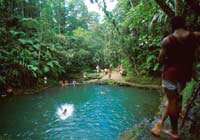
We take a break from the summer heat with a dip in the best swimming pool I’ve ever experienced.
Photo: Richard Murphy.
Niumaia then decided that it was time to stop to cook lunch. I had thought it was time for lunch hours before, but had kept it to myself. However, although I was cheered by the idea of food, I was skeptical about how we were going to cook it; the entire forest was totally soaked from an earlier downpour. My fellow hunters nonetheless cut branches from a dead tree, while I sat, grimly thinking that there was no way they were going to start a fire with that wood. As I watched, one of the group members pulled a yellowish blob from his pocket and began to pile the wood around it. To my complete astonishment, one match lit the blob, which then burned as though it had been soaked in gasoline. Mystified, I looked to the group for an explanation, and was told that the yellow blob was the pitch from a certain tree, which is highly flammable. The locals cut these trees from time to time so that the pitch will ooze out and can be harvested. Soon the wood had dried sufficiently for a pleasant little blaze. Gently, a large breadfruit was placed directly on top of the fire. The leaves of a ginger plant were cut and laid on the ground as a table. We chatted and dozed as flames engulfed our breadfruit.
In the midst of our midday nap, we were invaded by a troop of dogs, with their masters not far behind. The other group’s hunt had produced seven boars, one of them about a year old, the others only a few months. Three were alive and would be kept for pets and, later, slaughtered for food. The other three had been killed by the dogs and were destined to be our lunch.
When the breadfruit was spitting steam and the meat was done, we feasted. The dogs waited in polite attendance, focused on our every bite. They gobbled up whatever we threw them but never fought among themselves. Finally, we concluded our meal, leaving the “table” and scraps for the dogs to clean up. Seven hours into our hike, I felt totally rejuvenated.
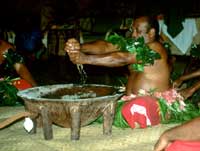
A big bowl of kava.
Photo: Richard Murphy.
By the time we returned to camp, three hours later, it was beginning to get dark. We bathed hastily and got ready for dinner. The women had come back from a successful expedition to the river, where they harvested prawns, eels, and water snails. We feasted and drank kava, a drink made from a root that tastes like muddy water, tingles your tongue, and makes you tired. But I, for one, didn’t need anything to make me tired; as the kerosene lantern ran out of fuel, I blissfully concluded one of the most privileged days of my life.
Well, my friends, it has been a busy week. I hope this insight into my life has given you a better understanding of what this ecologist and environmentalist does for a living.
If you have questions or comments, feel free to
email me at rmurphy000@aol.com. Do good work, have fun, think about what kind of world you want to live in, and then do whatever you can to make it so.

